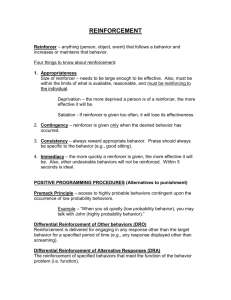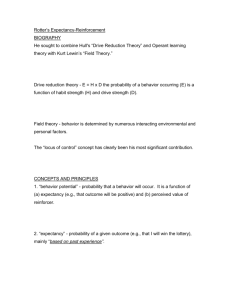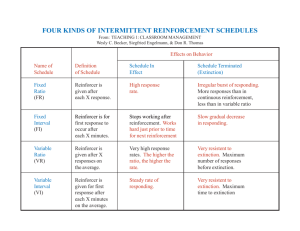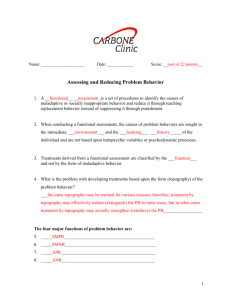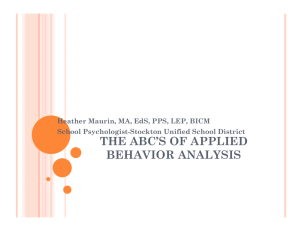Teaching the Vocal Child to Request (Mand)
advertisement
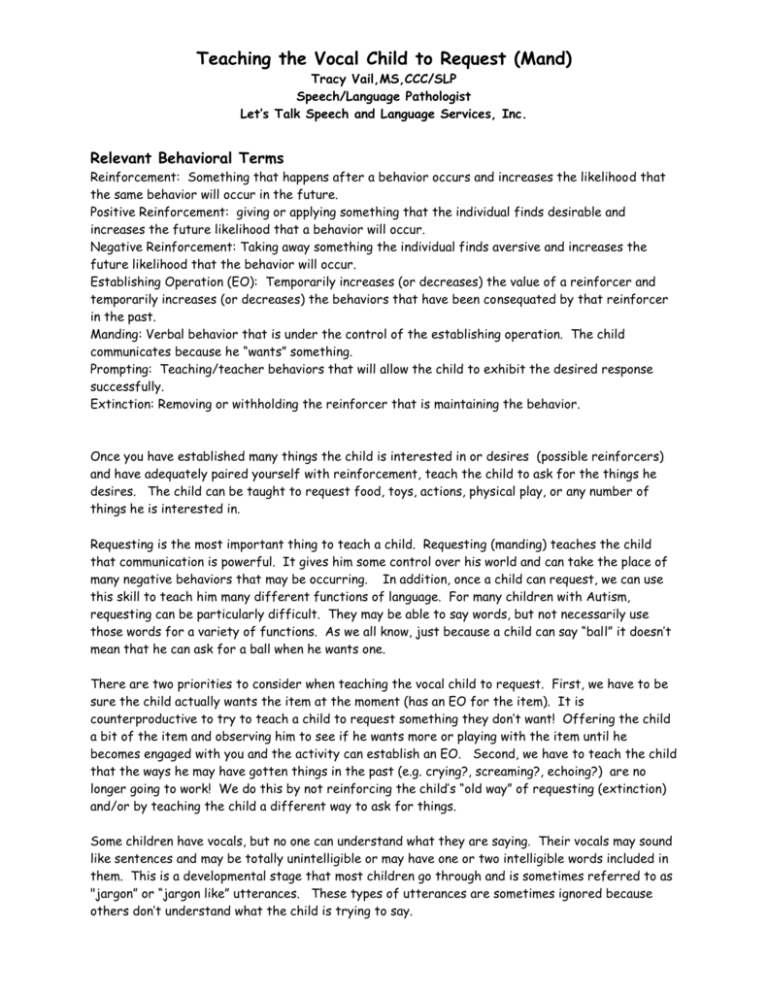
Teaching the Vocal Child to Request (Mand) Tracy Vail,MS,CCC/SLP Speech/Language Pathologist Let’s Talk Speech and Language Services, Inc. Relevant Behavioral Terms Reinforcement: Something that happens after a behavior occurs and increases the likelihood that the same behavior will occur in the future. Positive Reinforcement: giving or applying something that the individual finds desirable and increases the future likelihood that a behavior will occur. Negative Reinforcement: Taking away something the individual finds aversive and increases the future likelihood that the behavior will occur. Establishing Operation (EO): Temporarily increases (or decreases) the value of a reinforcer and temporarily increases (or decreases) the behaviors that have been consequated by that reinforcer in the past. Manding: Verbal behavior that is under the control of the establishing operation. The child communicates because he “wants” something. Prompting: Teaching/teacher behaviors that will allow the child to exhibit the desired response successfully. Extinction: Removing or withholding the reinforcer that is maintaining the behavior. Once you have established many things the child is interested in or desires (possible reinforcers) and have adequately paired yourself with reinforcement, teach the child to ask for the things he desires. The child can be taught to request food, toys, actions, physical play, or any number of things he is interested in. Requesting is the most important thing to teach a child. Requesting (manding) teaches the child that communication is powerful. It gives him some control over his world and can take the place of many negative behaviors that may be occurring. In addition, once a child can request, we can use this skill to teach him many different functions of language. For many children with Autism, requesting can be particularly difficult. They may be able to say words, but not necessarily use those words for a variety of functions. As we all know, just because a child can say “ball” it doesn’t mean that he can ask for a ball when he wants one. There are two priorities to consider when teaching the vocal child to request. First, we have to be sure the child actually wants the item at the moment (has an EO for the item). It is counterproductive to try to teach a child to request something they don’t want! Offering the child a bit of the item and observing him to see if he wants more or playing with the item until he becomes engaged with you and the activity can establish an EO. Second, we have to teach the child that the ways he may have gotten things in the past (e.g. crying?, screaming?, echoing?) are no longer going to work! We do this by not reinforcing the child’s “old way” of requesting (extinction) and/or by teaching the child a different way to ask for things. Some children have vocals, but no one can understand what they are saying. Their vocals may sound like sentences and may be totally unintelligible or may have one or two intelligible words included in them. This is a developmental stage that most children go through and is sometimes referred to as "jargon” or “jargon like” utterances. These types of utterances are sometimes ignored because others don’t understand what the child is trying to say. Other children may speak in nice clear words but only when imitating someone else. They may spontaneously repeat what they hear, right after they hear it, but do not request what they want. For example, when someone asks, “What do you want?” they say, “What do you want?” in response. This is sometimes referred to immediate echolalia. These responses don’t often serve any function for the child unless they have been reinforced. This occurs when the echolalia is followed by the child getting what he wants. For example, consider the interactions between the mother and child in this situation: The child is reaching for his juice. Mother says, “Do you want juice?” and the child echoes, “Do you want juice?” The mother then gives the child is juice. What the mother has actually taught the child to do is say “Do you want juice?” to ask for the juice. Sometimes these children spontaneously imitate but won’t imitate when you ask them to. For example, if the teacher says, “Say juice”, the child won’t say anything. This is sometimes referred to as the echo not being under instructional control. Other children have the ability to use phrases they have heard in one situation to serve a purpose in another situation. For example, they might repeat the words they hear on their favorite video in a different but related situation. Sometimes these words are said in a “cut and paste” fashion. In other words, the child is uses the words to serve a function similar to that in which they first learned the phrase. For example, consider the child who says, “He was a very hungry lion” whenever he wants something to eat. Perhaps the child says these words in this situation because when he watched his favorite video or heard a favorite story, one of the characters said this statement and then got something to eat. Sometimes this use of language is referred to as “delayed echolalia”. Sometimes this language becomes very functional for the child in the context of the family because the parents have also watched the video and so “interpret” what the child is saying. They increase the child’s use (reinforce) of this type of language by responding in a manner the child finds desirable (reinforcer). For example, in this situation since the parents have also seen the movie, when the child says, “He was a very hungry lion”, they “interpret” it to mean the child is hungry and give him some food. This reinforces the use of this sentence as a request (mand) for food. The problem occurs when the child leaves the home environment. Others don’t have a clue what the child is trying to communicate and so don’t reinforce the request. This can lead to frustrations and tantrums because the child is unable to communicate his needs any longer. Important considerations when teaching vocal children to mand 1. Even if children are able to speak using long sentences, begin by teaching single words. This is will insure the child learns which word actually gets the desired item and will also be useful when we are attempting to transfer the response to different verbal operants at a later date. It’s typically best to wait and introduce carrier phrases such as “I want” , “give me” etc. after the child has acquired strong imitation skills and you have successfully transferred many responses to tacts. 2. Be sure to teach all of the conditions under which the request is made. A “true mand” is purely under the control of the EO, which means that no one has said anything to the child first. It’s important to teach “pure mands” but also important to teach the child to respond under other conditions such as when someone asks him what he wants, which one he wants, when the item is visible and when the item is not visible. Be sure the child is able to discriminate among the different conditions before teaching them. 3. When teaching the child to request, be sure to teach the actual names of the items before teaching colors or other adjectives. For example, if a child likes to color, be sure he can ask for the “crayon” or “marker” before teaching him to ask for the colors. Otherwise, the color words may “replace” the name of the item when the child is requesting. 4. Words such as “more”, and “please” should be treated as adjectives and should not be taught until the child is able request the item using it’s “name”. Think carefully before 5. 6. 7. 8. 9. adding these types of words early in training because they increase the length and difficulty of the required response without adding any real “value”. When adding carrier phrases, be sure to teach a wide variety within the context of the same activity or set of conditions. Teach both those you want the child to use with other children as well as those you want the child to use with adults. “May I have the car please? May work well with teachers and parents but might not get too far on the playground at preschool! Be sure the child never “gets” anything for negative behavior. You may see an escalation in the negative behaviors (extinction burst) the child has used to get desired items in the past early in training. It is important not to respond to these negative behaviors. If these behaviors still work, there will be no need for words! Avoid situations that are a “stand off”. In other words, the situation should not be “you have to talk before you get this”. Use whatever prompting strategies (signs, pictures, “fillins” are necessary to allow the child access to the reinforcer. Just hearing you say the name of the item and having that name paired with reinforcement will lead to an increased likelihood that the word will be used in the future. When attempting to teach children to tact (label) nouns, verbs, prepositions, adjectives or adverbs, it is often much easier to begin with requesting (manding) then transferring to the label (tact). For example, if you want to teach the child to label “dark”, it might be easier to first find a condition under which he would find dark desirable (playing with flashlights?), teach him to ask for “dark” then, transfer that response to a label (tact) of “dark”. “Cleaning up” mild articulation errors can also be accomplished during manding. When the child first learns a specific word, you might accept any intelligible approximation. After the child can request the item with no prompting, have him repeat the word after you a couple of times before giving him the desired item to improve the articulation of the word. Give the child the item (reinforce) after the best production. Each child is different so judge how many times you can ask the child to repeat the word based on his learning history. It’s important not to ask a child to repeat the word so many times that he loses interest in the item and talking in general! T. Vail 7/01

